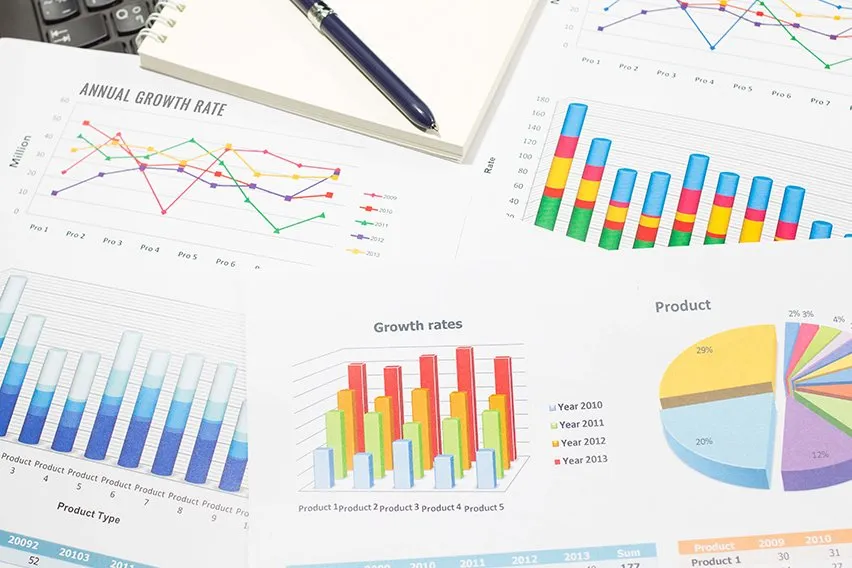Compound Annual Growth Rate (CAGR): Overview & Calculation

There are a number of tools, techniques and metrics that an investor will look at before putting money down as an investment.
The world of investment is a risky one. So it’s understandable that you will want to gather as much information as possible before putting capital into a stock.
One such tool is using the compound annual growth rate. But what exactly is CAGR?
We’ll take a closer look at the definition and give you a general overview. We’ll also show you how you can calculate CAGR for any potential investments you may be considering.
Here’s What We’ll Cover:
What Is the Compound Annual Growth Rate?
What Are the Advantages of Using the Compound Annual Growth Rate?
What Are the Disadvantages of Using the Compound Annual Growth Rate?
What Is the Compound Annual Growth Rate?
Compound Growth Rate, or CAGR, is the measure of an investment’s annual growth rate over time. This is with the effect of compounding taken into account.
CAGR is regularly used to measure and compare the past performance of an investment. It can also be used to project the expected future returns.
So essentially, anyone who wants to estimate the gain from an investment will use CAGR to determine the profit of their potential investment over a given period of time.
CAGR is measured with the assumption that any profits are reinvested at the end of each year.
It’s important to note that the compound annual growth rate is an approximate figure. This is rather than a true return rate.
So you would say that CAGR is a number that describes the rate at which the investment would have grown. This is if it had grown at a consistent rate every year during the entire investment period. As well as with the assumption that all profits were reinvested at the end of each year.

What Is Compound Interest?
To fully understand the compound annual growth rate, you will first need to have a basic understanding of compound interest.
Compound interest can be defined in finance as the interest that is earned not only on the initial amount invested, but also on any interest that accrues over time. So basically compound interest is the interest calculated on top of the initial investment.
The formula for figuring out compound interest is relatively complex. This is because it includes not only the annual interest rate and period of time, but also the number of times that the interest is compounded per year.
The formula for compound interest is as follows:
FV = PV (1+r/m)mt
This is where:
- FV = the future value of the investment
- PV = the initial balance, or the present value of the investment
- r = the annual interest rate as a decimal
- m = the number of times the interest is compounded per year
- t = the number of years that the money is invested for
So if the interest is compounded once per year, or m = 1, then r would be the compound annual growth rate.
What Is the CAGR Formula?
Now that we’ve got a better understanding of what compound interest is, let’s take a look at the compound annual growth rate formula.
The CAGR formula only requires:
- The ending value of the investment
- The beginning value
- The number of compounding years to calculate
It can be calculated by dividing the ending value by the beginning value. You would then raise that figure to the inverse number of years, then finally subtract it by one.
So in a formulaic sense, it would look like this:
CAGR = EVBV1n-1
This is where:
- EV = Ending Value
- BV = Beginning Value
- N = Number of Compounding Periods
What Are the Advantages of Using the Compound Annual Growth Rate?
CAGR is a great tool when you want to compare a variety of investments over a similar period of investment.
One of the best advantages over a standard annualised rate of return is that CAGR isn’t actually influenced by any percentage changes. So over the period of investment, it is less likely that it could lead to some misleading results.
So for example, let’s say that you make a $100 investment that makes you a 25% return in the first year. The value will have risen from $100 to $125.
If all of the capital was reinvested in the same investment for the second year, which then yielded a -25% return, then the value of the investment would fall to $93.75. This is therefore less than the initial amount you invested.
To compare CAGR to average returns, it would look like this:
|
Year |
Amount |
Return |
|
0 |
$100 |
– |
|
1 |
$125 |
25% |
|
2 |
$93.75 |
-25% |
|
Average Returns |
0% | |
|
CAGR |
-3% |
So as you can clearly see, you will have made a loss on your initial investment over your two year period. But whilst averaging returns indicate that no loss has been made, CAGR shows a -3% loss over its full time horizon.

What Are the Disadvantages of Using the Compound Annual Growth Rate?
A big disadvantage of using CAGR is that it assumes that growth will be constant throughout the investment period. This is known as smoothing and may give you results that differ from the actual situation with a volatile investment.
So if we take your $100 investment that we used earlier:
|
Year |
Amount |
CAGR (%) |
CAGR ($) |
|
0 |
$100 |
– |
$100 |
|
1 |
$125 |
-3% |
$96.825 |
|
2 |
$93.75 |
-3% |
$93.75 |
You can see that CAGR correctly shows the end value of the investment if a -3% CAGR was applied over a two-year period.
But CAGR assumes that the investment falls at a consistent rate of 3%. This is incorrect as it in fact grew by 25% in the first year.
Key Takeaways
Compound Annual Growth Rate is a great tool for quickly figuring out the potential growth of an investment.
Though as with any investment metric, it should be taken and used with caution.
CAGR can be used as a swift comparison tool between a number of investment options. But any real money decisions should be made with a greater consideration of the trade-offs between your risk and any potential return.
Any investment tool should always be used alongside other metrics so that you can have the clearest idea possible. Especially when you’re investing a large amount of capital.
Are you looking for more business advice on everything from starting a new business to new business practices?
Then check out the FreshBooks Resource Hub.
RELATED ARTICLES

 What Is the Discount Factor & How to Calculate It?
What Is the Discount Factor & How to Calculate It? What Is a Certificate of Deposit (CD) & How Does It Work?
What Is a Certificate of Deposit (CD) & How Does It Work? What Are Trade Creditors?
What Are Trade Creditors? What Is a BSB Number & How to Get One?
What Is a BSB Number & How to Get One? What Is a Swift Code & How Does It Work?
What Is a Swift Code & How Does It Work? What Are Franking Credits & How Do They Work?
What Are Franking Credits & How Do They Work?